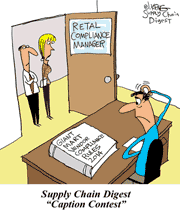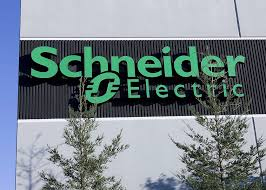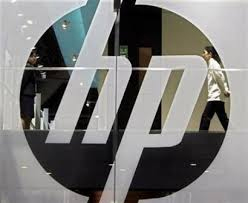 |
April 25, 2014 - Supply Chain Flagship Newsletter |
 |
| THIS WEEK'S SPONSOR: GENPACT |
 |
|
 |
|
||||||||||||||||||||||||||||||||||||||||||||||||||||||||||||||||||||||||||||||
Amazon and Supply Chain Innovation
|
|||||||||||||||||||||||||||||||||||||||||||||||||||||||||||||||||||||||||||||||
| GILMORE SAYS: |
"I am aware that Amazon, for example, did not necessarily invent by itself any of its many ideas, but they sure are running with them." WHAT DO YOU SAY? |
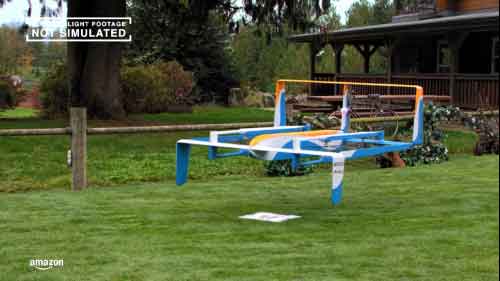
Use of drones for package delivery – Amazon says it will be ready to go if and when the FAA ever releases regulations relative to commercial drones, which it is expected to do sometime in 2015.
Roll-out of a delivery locker concept in which orders are placed in secure storage units, often in Staples or 7-11 stores but elsewhere as well, in urban markets where parcels can't be left on a front porch or an apartment hallway, often enabling round the clock consumer pick-up.
New "Dash" device that enables consumers to order groceries and other items by scanning UPC codes or speaking the item names into the wand-like device.
Setting up co-located, mini-fulfillment centers in large customers DCs, such as it is doing with Procter & Gamble and a few others.
eFulfillment, of course, is spawning lots of new ideas. Walmart is now jumping all over a concept pioneered by some French and German grocers called "click and collect," in which on-line orders are loaded into a customer's car at designated areas outside a retail store or distribution center. Walmart is also piloting a version of this idea in the UK in which the orders would be placed in temperature controlled lockers inside the store. UK retailer TESCO and others are looking at putting such lockers outside office buildings, in parking lots for the London Tube, and other high traffic areas.
It looks like click and connect will wind up being the eFulfillment "killer app," by the way, and certainly add some big value back to brick and mortar.
eFulfillment is relatively new and now coming into its own, so maybe it's natural we see lots of innovation there. But I would still argue that Amazon simply had a different, more innovative mindset here than everyone else, and that this has simply propelled innovation by others forward, out of necessity. Would we have Walmart Labs, its ecommerce think tank in Silicon Valley, if there hadn't been Amazon? Maybe not.
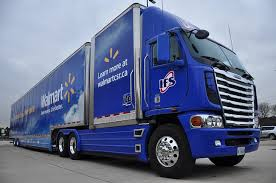 Speaking of Walmart, in the past year or so, it has released two concept truck designs. One, called SuperCube, may be able to handle as much as 30% additional volume, in part by use of an additional storage module that sits between the main trailer and the truck cab.
Speaking of Walmart, in the past year or so, it has released two concept truck designs. One, called SuperCube, may be able to handle as much as 30% additional volume, in part by use of an additional storage module that sits between the main trailer and the truck cab.
Just recently, we got a look at Walmart's new WAVE (Walmart Advanced Vehicle Experience) truck concept. It is some 20% more aerodynamic, which will result in improved gas mileage, though Walmart hasn't said how much.
Now in fairness, there have been some similar type designs coming out of Europe, but not much from US truck and trailer manufacturers – until driven by Walmart. It takes Walmart to bring the parties together for an integrated design? The Dept. of Energy has also been able to do it with its sponsorship of "Supertruck" program, by the way.
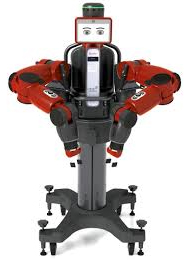 We've not seen much yet, but I fully expect Google to soon produce a revolutionary line of industrial robots, many of them targeted at supply chain and logistics applications. Rodney Brooks and the folks at Rethink Robotics have certainly made a start with Baxter, the robot that is taught how to perform tasks by operations personnel rather than through programming, but I expect Google to advance the field far and fast.
We've not seen much yet, but I fully expect Google to soon produce a revolutionary line of industrial robots, many of them targeted at supply chain and logistics applications. Rodney Brooks and the folks at Rethink Robotics have certainly made a start with Baxter, the robot that is taught how to perform tasks by operations personnel rather than through programming, but I expect Google to advance the field far and fast.
Google has acquired at least seven robotic companies in the past year. What are its plans? No one knows for sure, but the New York Times wrote that: "A realistic case, according to several specialists, would be automating portions of an existing supply chain that stretches from a factory floor to the companies that ship and deliver goods to a consumer's doorstep."
"The opportunity is massive," said Andrew McAfee, a principal research scientist at the MIT Center for Digital Business. "There are still people who walk around in factories and pick things up in distribution centers and work in the back rooms of grocery stores."
There are also tremendous supply chain opportunities with Google Glasses, a subject we will save for another day.
In fairness, Amazon seems to be able to spend and invest almost without limit and not get crushed in the stock market due to poor earnings. Walmart is the world's largest company by sales and is driven to improve sustainability as a top imperative. Google has bazillions of dollars and seems to be able to fund just about anything it wants.
That said, I think we should all appreciate that right now that we are in a historic period of supply chain innovation, much but not all of it, driven by ecommerce.
Just as importantly, Amazon, Google and now Walmart and a few others are aggressively innovating in areas and ways that might serve to shock some of us out of our limited paths, and look for opportunities to innovate in processes and technology where we have simply been stuck in our mental boxes.
Hat's off to Jeff Bezos.
Any reaction to Gilmore's Amazon and Supply Chain Innovation summary? Let us know your thoughts at the Feedback section below.
| View Web/Printable Version of this Column |
|
|
|
YOUR FEEDBACK
We received a few good letters from our First Thoughts piece Big, Big Supply Chain Data a couple of weeks ago.
That includes our Feedback of the Week from David Schneider, who says in part that the key is asking the right questions.
You'll find that good feedback and others below.
Feedback of the Week: On Big, Big Supply Chain Data
Every year we have more data - but how much of it is useful, and how much of it become information, become the real question. Data becomes information the moment it answers the question asked. Until then, it is just data, nothing more. Better analytics may help us sift through the data faster, but the best of the analytics packages are constrained by something that technology will never improve; the ability to ask the right question. Data is the fuel that drives execution improvement. Information is the fuel that drives tactical improvement. Questions are the inspiration that drives Strategic improvement. We need data to measure and improve execution performance. We need Information to decide on the tactical options available, and to develop new versions of tactics to deploy. These are all good, but create marginal improvements. Until we start asking better questions, as in the questions focusing on The Goal of the Supply Chain, we won't improve our strategic strength of our supply chains. David K. Schneider |
||
| More on Big, Big Supply Chain Data | ||
Congratulations on your first part on "big, big supply chain data." I would like to share one example of big data which I consider very helpful to avoid human casualties these days as to prevent catastrophic floods in particular risk regions.
|
||
Big Data? No big deal. I have been part of the IT and supply chain community for going on half a century now. During that time I have seen a lot of wondrous things. Heck, at one point I even thought that being able to make sense of little holes punched in cards was fascinating. I've seen a lot of hype and industry movement generated by simple three letter acronyms. Sometimes we need to make an idea sound "Big" to get it noticed. That is what I think of "Big Data". Nothing really new, but it kicks off a forum for discussion. And this is a good thing, because lots of people need to be thinking about how to share and use data in order to get real value out of it. Think for a moment about EDI and CPFR / ECR. These well-known technologies have been around for about 20 years. Both depend on getting multiple partners to share and use data. But we didn't call them "Big Data". And yes, advanced analytics were applied to determine when and what is being delivered, or was consumed. Comes the rub. Getting people to ‘share' and to ‘use' in a cooperative manner. The profession and art of Supply Chain Management could advance brilliantly if we could just learn to trust each other and to share. EDI or basically "Business to Business Data Integration" has never gotten the traction it should have. Such a simply concept, sending orders, shipment and billing data in an understandable electronic format. Collaborative Planning, Forecasting, and Replenishment, and Efficient Consumer Response – Now these are really meat and potatoes Big Data stuff. But again, fairly compartmentalized. Intelligent businesses, supported by technology, have been doing this kind of stuff for years. I guess if giving it a tag like "Big Data" furthers the movement I am all for it. Breaking the data out of its silos will be the challenge, are we up for it? But we really need to add another word to the mix so that we can have a legitimate TLA. Something that encompasses both the capture, sharing and analysis of all that data. Maybe the word "Omnibus" would work. "BDO". Yeah, that rolls off the tongue pretty easy. Steven R. Murray Supply Chain Visions
|
||
| I like and agree with your article completely. I have had a vision since early 2008 that is so related to supply chain and technology, and the times and it starts off slowly and grows as people see the advantages it has not only in businesses but in employment and the economy. It Involves data proper usage, visibility, collaboration, and a new approach that actually isn't new for all. I won't go into details in this email. I am industrial engineer and have been a supply chain consultant for 20 years. I am also an inventor. Shelley Jordan |
||
SUPPLY CHAIN TRIVIA ANSWER
Q: MIT's Jay Forrester contributed two major supply chain innovations all the way back in the early 1960S, one a concept, the other an exercise. What are they?
A: Concept: The Bullwhip Effect; Exercise: The Beer Game, which illustrates the Bullwhip Effect.
| © SupplyChainDigest™ 2003-2013. All Rights Reserved. SupplyChainDigest PO Box 714 Springboro, Ohio 45066 |
POWERED BY: XDIMENSION
|
